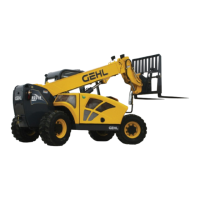PRINTED IN U.S.A. 11 50960066/AP0813
Suspended Load Safety Reminders
The handling of suspended loads by means of a truss
boom, winch, boom mounted lift hook or other similar
device can introduce dynamic forces affecting the sta-
bility of the machine that are not considered in the sta-
bility criteria of industry test standards. Grades and
sudden starts, stops and turns can cause the load to
swing and create a hazard. Refer to the following
guidelines for handling suspended loads.
Ü DO NOT exceed the rated capacity of the tele-
scopic handler as equipped for handling suspend-
ed loads. The weight of the rigging must be
included as part of the load.
Ü During transport, the length of the rigging
between the attachment and load should be as
short as possible to reduce booms height and
movement. DO NOT raise the load more than 12
inches (305 mm) above the ground, or raise the
boom more than 45 degrees.
Ü Only lift the load vertically – NEVER drag it hor-
izontally.
SAFETY
WARNING
U.S. OSHA regulations effective November 8,
2010 (29 CFR Part 1926, Subpart CC - Cranes
and Derricks in Construction) include require-
ments for employers that use powered indus-
trial trucks ("forklifts") configured to hoist (by
means of a winch or hook) and move sus-
pended loads horizontally. In particular, this
regulation applies to any rough-terrain forklift
(e.g., "telescopic handler") equipped with a jib
or truss boom with a hook (with or without a
winch), or a hook assembly attached to the
forks. [Note: This regulation is in addition to
the OSHA regulation that requires specific
forklift operator training: §1910.178(l).]
When a forklift / telescopic handler is config-
ured and used for hoisting, the employer must
ensure that:
1. Forklift, lift equipment and rigging have
been inspected (each shift, month and
year) and are in good, safe condition and
properly installed.
2. An operator's manual and applicable load
charts are on the forklift.
3. Work zone ground conditions can support
the equipment and load. Any hazardous
conditions in the work area have been
identified, and the operator notified.
4. Equipment is being used within its rated
capacity and in accordance with the manu-
facturer's instructions.
5. Operator and crew members have been
trained in the safe use and operation of the
equipment, including how to avoid electro-
cution.
6. During use, no part of the equipment, load
line or load will be within the minimum
clearance distance specified by OSHA [10
feet (3.0 m), and more for lines rated over
50 kV] of any energized power line, and
any taglines used are non-conductive.
7. In addition, for lift equipment with a rated
capacity greater than 2000 lbs. (907 kg),
the employer must ensure that:
a.) An accessible fire extinguisher is on
the forklift;
b.) Monthly and annual inspections are
performed and documented, and
records retained (three months for
monthly, one year for annual);
c.) Before November 10, 2014, operators
must have had the additional training
and qualification / certification required
by OSHA regulations §1926.1427 and
§1926.1430.
Note: Refer to the full text of the OSHA crane
regulation (29 CFR Part 1926, Subpart CC) for
a detailed description of the regulatory
requirements.

